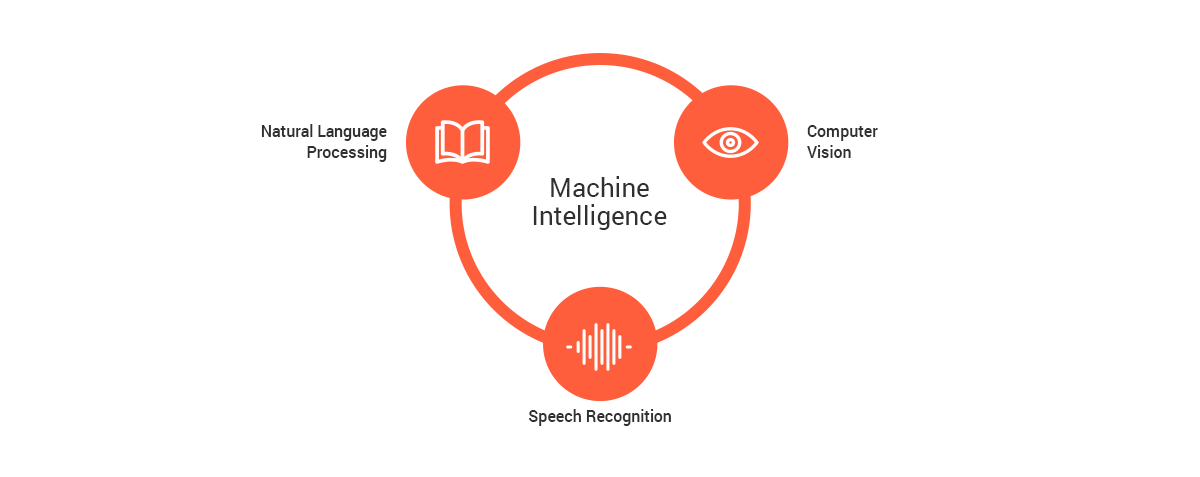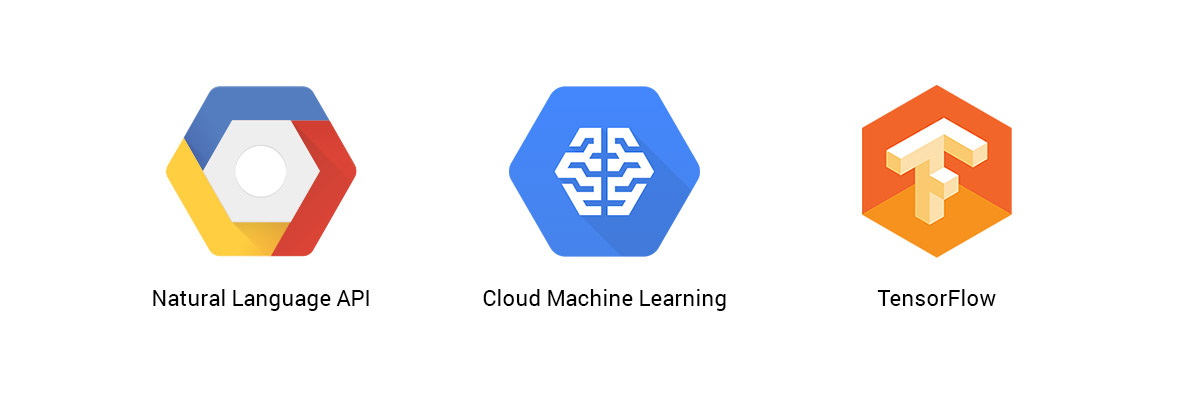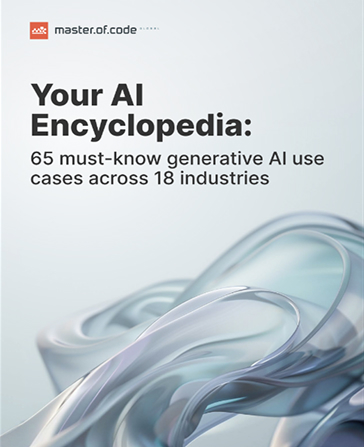Artificial Intelligence (AI) and Machine Learning (ML) are some of the hottest buzzwords in tech these days. In 2016 more than $5 billion of venture funding flooded into machine learning startups. AI and machine learning algorithms have the potential to evolve workplaces and change entire industries In this post, I will explain what these two technologies are and their potential for your business.
Table of Contents
The Basics of Artificial Intelligence
Artificial (machine) intelligence is a branch of computer science that aims to create intelligent machines. Basically there are two types of AI: general and narrow intelligence. Artificial General Intelligence is a computer capable of doing anything a human can do. With Artificial Narrow Intelligence a computer is capable of doing what a human can do, but only within narrow bounds.
Artificial intelligence includes subfields such as computer vision, speech recognition, natural language processing and others.

A few words about each subfield:
Thanks to our eyes and brains humans have the ability to see and visually sense the world around us. Computer vision gives a similar capability to computers via analysis and understanding of useful information from the camera or images that have already been taken. Facebook already monitors what the phone camera is focused on and recognizes objects. The received information helps detect what’s going on in the real world and evolve the machine learning.
Technologies also enable machines to recognize and translate spoken languages and transform them into text. The last technology mentioned is natural language processing. This is a way for computer programs to converse with people in a language and format that people understand. This involves features including natural language understanding (understanding what the user is saying), natural language processing (replying to the user in a logical way), and sentiment analysis (the ability to understand the user’s tone and intent. NLP is integrated to new Pixel Buds headphones by Google and helps with the real-time translation in 40 different languages by Google Translate.
What Do Machine Learning Algorithms Mean
Simply put, machine learning is software automated and controlled algorithms. They are processes that follow set rules designed for problem-solving. They are not explicitly programmed and are used to find patterns in data. ML outcomes can be achieved in two ways: Supervised and Unsupervised.
When we use software to tell the algorithm specifically what we want to discover, it is called supervised ML. The machine learning algorithms use a ‘target’ variable or attribute to ‘train’ a model based on the data in the target variable.
Unsupervised ML is when the machine can learn to identify complex processes and patterns without a human to provide guidance along the way. It uses clustering as an application, where the dataset records are automatically segmented into groups. Those groups are similar to records in their own group and dissimilar to records in other groups.
At the last F8 conference, Facebook introduced an open-source library called Caffe 2. Other tech giants also presented their machine learning libraries: CoreML by Apple, TensorFlow and TensorFlowLite by Google.

How AI and ML Can Actually Help Your Business
Ravindra (Ravi) Simhambhatla, VP of Commercial Technology and Corporate Systems at United Airlines, sees artificial intelligence as critical to operational efficiency: from allocating gates to assigning employees, routing bags, flight planning, and conducting commercial transactions. He also views AI as a customer service imperative.
We talk a lot about personalization, but it has been inadequate in airlines. I strongly believe that machine learning is going to play a really pivotal role in taking us into the future and we are very focused on that right now.
Vectorform says that AI and ML model human procedures, and while humans with experience can start to make predictions, those predictions still have accuracy issues. With people, usually the more experience and the more they can look at contributing factors, their predictions become more accurate. That accuracy, however, likely won’t reach into the 90 percent range even in the best scenarios. Where AI and ML can eventually perform better is through the ability to take on a much larger history and set of contributing factors. In the end, the adjustments can be partially automated, but they often still require some human input.
Human accuracy likely won’t reach into the 90 percent range even in the best scenarios
Almost every business industry can benefit from ML. ML-powered systems can provide customer service, forecasting, fraud detection, and even recruitment. If your business doesn’t include counted processes, that doesn’t mean ML can not come you in handy. We can help you achieve your business perspectives with machine learning algorithms—consider partnering with a machine learning development company. Just contact us.
Customer Support
By using natural language processing (NLP) companies can better understand how to respond to customer questions and general feedback. NLP helps computer programs to understand the human language and format people use to communicate. At the Google Cloud Next conference 2017 Apoorv Saxena, a product manager on the Google Cloud team, explained how organizations can use company’s products to improve their customer service. Saxena referenced Dan Nelson’s case study, who is the head of data for online supermarket Ocado, that explains how his organization has implemented ML. Ocado’s contact center gets roughly 2,000 emails a day, ranging from refund requests to website trouble, and general feedback.
Starting with the Natural Language API, they were able to tag message request such as “Feedback” or “Positive”. However, they then built a custom solution with Cloud Machine Learning and TensorFlow to get more detailed filtering. It sits outside of their storage layer and allows the company to more effectively triage their customer service requests, Nelson said.

As a result, Ocado was able to respond to urgent emails four times faster and save money on headcount in the contact center.
If you are all about optimizing customer support, check our article Why Use Natural Language Processing for Customer Support Chatbots
Forecasting
When it comes to demand forecasting, machine learning algorithms can be especially helpful in complex scenarios. Machines are able to do a much better job of forecasting difficult situations than humans. They leverage the knowledge, experience and skills of planners, and other experts in a highly efficient and effective way across a broad range of data.
More than 30% of items are sold on promotion at Danone — accounting for nearly 70% of forecast error. The global foods company wanted to predict promotional lift to baseline demand to get timely production and balanced inventory deployment for channel and store supplies.
Using ML, Danone lowered their forecast error by 20% and lost sales were lowered by 30%. They increased service level to 98.6% and realized a 30% reduction in product obsolescence. The company also cut demand planner workload in half, allowing planners to focus on more valued activities.
Using ML, Danone lowered their forecast error by 20% and lost sales were lowered by 30%. They increased service level to 98.6% and realized a 30% reduction in product obsolescence
Fraud Detection
In 2016, fraud cost the average e-commerce retailer over 7% of total revenue. Al Pascual, research director head of fraud and security at Javelin, said:
We consider this to be a very high percentage of revenue to lose to fraud and fraud mitigation expenditures, especially considering the lost opportunity for investing that money in revenue-generating activities. It signals a very aggressive fraud environment, especially in the digital space.
AI is taking a chance to became a trusted tool for detecting and fighting fraud.
As a financial company, PayPal worries about fraudsters, armed with stolen account logging, credentials and using a credit card linked to it. The American Banker insures that PayPal has more reason than most to worry as every second the company generates $10,900 in payments. Also, it handled 4.9 billion payments in 2015 for 188 million customers in 202 countries.
Hui Wang, company’s senior director of global risk and data sciences, says that they «want to stop these guys at our door». AI has been shown to be a handy tool for PayPal. The company uses a homegrown artificial intelligence engine built with open-source tools to detect suspicious activity and separate false alarms from true fraud. The effort has forged a bond between its human fraud analysts and its AI program. Human detectives develop scenarios for bad and good user behavior, then they feed them into the AI program. Wang:
It’s a unique combination of human story-based intelligence, data mining, and machine learning algorithms.
To make the company able to focus on real financial crimes, the key goal for the fraud team is to reduce the number of false alarms and avoid blocking the accounts of legitimate customers as well.
If the same account has been accessed by five internet protocol addresses within five days, traditional analytics software sees a pattern and flags that as suspicious. Yet PayPal’s artificial intelligence system can look at each case more closely and see that the user is a pilot buying gifts for his family while on the job.
In order for us to identify that, we need to feed this information to the artificial intelligence machine, so the machine will be able to say you know what, there is a good side of a seemingly bad story. Then the machine will be able to provide a good assessment.
PayPal has been using machine learning algorithms for 10 years but has not reduced its human workforce in fraud and risk analytics. Computers have freed the human detectives up to detect and identify new types of fraud patterns, which they can then inform the AI machine about.
Human Resources
Artificial intelligence helps HR managers and directors make decisions with greater confidence. The technology helps with better management of data-heavy tasks, spotting top talent in unlikely places, and even improving employee satisfaction to reduce turnover rates. Algorithms are changing human resources in several ways.
The technology can help candidates find the right job. Finding and recruiting candidates can take a while. Your HR professional checks social media for hours, but AI can accomplish the task of searching social networks, websites and online resumes to find the best candidates.
Machine learning algorithms can assess candidates to find the best vacancy for them. Machines can detect patterns faster and with a greater degree of accuracy than HRs can. Programs can determine where they might fit best in the company by correlating candidate’s’ past experiences and relevant skills.
Evaluate more candidates faster with ML. Artificial intelligence programs can evaluate CVs of successful employees and identify new candidates with similar experience and traits.
AI can also assist in video interviews by detecting body language patterns and evaluating aspects such as word choice. Machines analyze arrays of data to find the best new hires.
AI can make regular, unbiased performance reviews to improve employee satisfaction. Being impartial during performance reviews may be challenging for the reviewer. The algorithms could evaluate the data without any personal bias.
Conclusion
AI can analyze data and make predictions faster and with a greater degree of accuracy. With AI performing many routine tasks, it frees up your specialists to focus on the “human” elements of their jobs. Its comprehensive capabilities will undoubtedly contribute to the continuing evolution of job titles in a long-term perspective, but you can economically benefit from AI and ML in the short term by exploring machine learning consulting services. Do not delay.
Master of Code designs, builds, and launches exceptional mobile, web, and conversational experiences.






